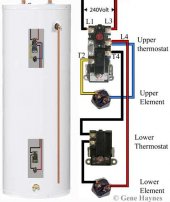if only 3000w or less or more is available it should still heat the water with the elements just slower correct?
No. If you are supplying a heating element with regular 220 V AC power then a 3 kW element will draw 3 kW. It will be on or off, no in-between.
The only thing which can vary the power draw is changing the nature of the power supply, either varying the AC voltage and/or the AC waveform.
If your system is unable to supply 3 kW, it will overload.
If your system is capable of blending PV output with grid power, then it will use all the available PV power and supplement what it needs with grid power. If your system uses batteries then it will use those to supplement the power demand.
But the element will draw 3 kW.
There are however smart diverters which are capable of modifying the AC power supply presented to the water heating element. They work using various methods such as burst fire or PWM control. In these cases then the power the heating element operates at can indeed be controlled anywhere between nothing and its power rating.
I have such a device for my hot water storage tank. Mine is a single 3.6 kW heating element in a 315 litre tank (we are 240 V AC here). The smart diverter monitors how much excess solar PV (IOW what is being exported to the grid) and it adjusts the amount of power being sent to the water heating element so as to avoid importing power from the grid. If by the end of the day the water heater's thermostat switch has not opened (indicating it has not completed a heating cycle), then the smart diverter waits until my off-peak energy is available late at night to perform a boost completing the heating cycle then.
I've not had it in operation for a full year but I expect the 90% of our hot water power will be from our solar PV, with 10% being off-peak grid supplemental.
If using a basic timer controller, or an integrated inverter control which monitors PV output (or grid exports) to determine when to switch the water heater on, then it can help to use a lower power heating element as this means the solar PV can begin diversion earlier and finish later. The heating cycle does take longer as well but in general you will squeeze a bit more from the PV supply this way and require a bit less supplemental energy. The exact maths is obviously going to vary depending on your specific hot water consumption, PV output, location etc etc.
Not sure what sort of elements are available in the USA but here we can choose from 1.8, 2.4, 3.6 and 4.8 kW heating elements.




